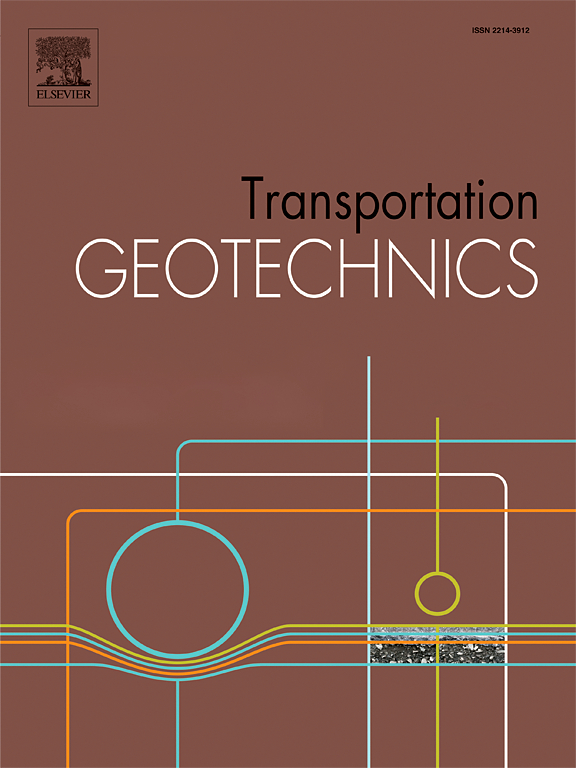Field implementation of a rational Otta seal mix design for enhanced performance on low-volume roads
IF 4.9
2区 工程技术
Q1 ENGINEERING, CIVIL
引用次数: 0
Abstract
Low-volume roads connecting rural communities and agricultural fields face unique challenges due to heavy traffic and constrained budgets for maintenance and rehabilitation. The Otta seal surfacing technique utilizing bituminous material and graded aggregates to create a durable road surface has emerged as a promising solution. This study explores a rational mix design, a modified McLeod method, for Otta seal application considering local material properties, and compares it with existing design guidelines. The study involves constructing test sections following a rational design technique and conventional Overby recommended guidelines. The performance of the test sections was assessed by testing skid resistance, surface roughness, dust generation, and structural stiffness over a two-year period. The test section constructed following the modified McLeod method outperformed sections built per traditional Overby guidelines in terms of cost-effectiveness and overall performance. Specifically, the test section that was constructed using the modified McLeod method exhibited the lowest roughness, dust, and loose aggregate from the surface. Results from life cycle cost analysis (LCCA) highlight the economic benefits of the rational mix design technique, demonstrating the economic advantages of the rational mix design, showcasing lower construction and maintenance costs. By adapting the modified McLeod method to suit the local aggregate materials, engineers can achieve more appropriate and accurate application rates for both aggregates and binders, thereby optimizing the performance of the overall mixture. The study contributes practical insights for optimizing Otta-seal surfacing, emphasizing the significance of using local material properties and rational mix design for enhancing the longevity and cost-effectiveness of low-volume roads in Iowa.
现场实施合理的Otta密封混合设计,提高在小流量道路上的性能
由于交通繁忙以及维护和修复预算有限,连接农村社区和农田的小容量道路面临着独特的挑战。Otta密封路面技术利用沥青材料和分级集料来创造持久的路面,这是一种很有前途的解决方案。本研究探索了一种合理的混合设计,一种改进的McLeod方法,用于Otta密封应用,考虑当地材料的特性,并将其与现有的设计指南进行了比较。该研究包括按照合理的设计技术和传统的Overby推荐指南构建测试部分。在两年的时间里,测试部分的性能通过测试防滑性、表面粗糙度、粉尘产生和结构刚度来评估。根据改进的McLeod方法构建的测试段在成本效益和整体性能方面优于按照传统Overby指南构建的测试段。具体来说,使用改进的McLeod方法构建的测试部分显示出最低的粗糙度,灰尘和表面松散的骨料。生命周期成本分析(LCCA)的结果突出了合理配合比设计技术的经济效益,展示了合理配合比设计的经济优势,展示了较低的建设和维护成本。通过改进的McLeod方法来适应当地的骨料材料,工程师可以获得更合适和准确的骨料和粘结剂的施用量,从而优化整体混合料的性能。该研究为优化Otta-seal路面提供了实践见解,强调了利用当地材料特性和合理混合设计的重要性,以提高爱荷华州低流量道路的使用寿命和成本效益。
本文章由计算机程序翻译,如有差异,请以英文原文为准。
求助全文
约1分钟内获得全文
求助全文
来源期刊

Transportation Geotechnics
Social Sciences-Transportation
CiteScore
8.10
自引率
11.30%
发文量
194
审稿时长
51 days
期刊介绍:
Transportation Geotechnics is a journal dedicated to publishing high-quality, theoretical, and applied papers that cover all facets of geotechnics for transportation infrastructure such as roads, highways, railways, underground railways, airfields, and waterways. The journal places a special emphasis on case studies that present original work relevant to the sustainable construction of transportation infrastructure. The scope of topics it addresses includes the geotechnical properties of geomaterials for sustainable and rational design and construction, the behavior of compacted and stabilized geomaterials, the use of geosynthetics and reinforcement in constructed layers and interlayers, ground improvement and slope stability for transportation infrastructures, compaction technology and management, maintenance technology, the impact of climate, embankments for highways and high-speed trains, transition zones, dredging, underwater geotechnics for infrastructure purposes, and the modeling of multi-layered structures and supporting ground under dynamic and repeated loads.
 求助内容:
求助内容: 应助结果提醒方式:
应助结果提醒方式:


